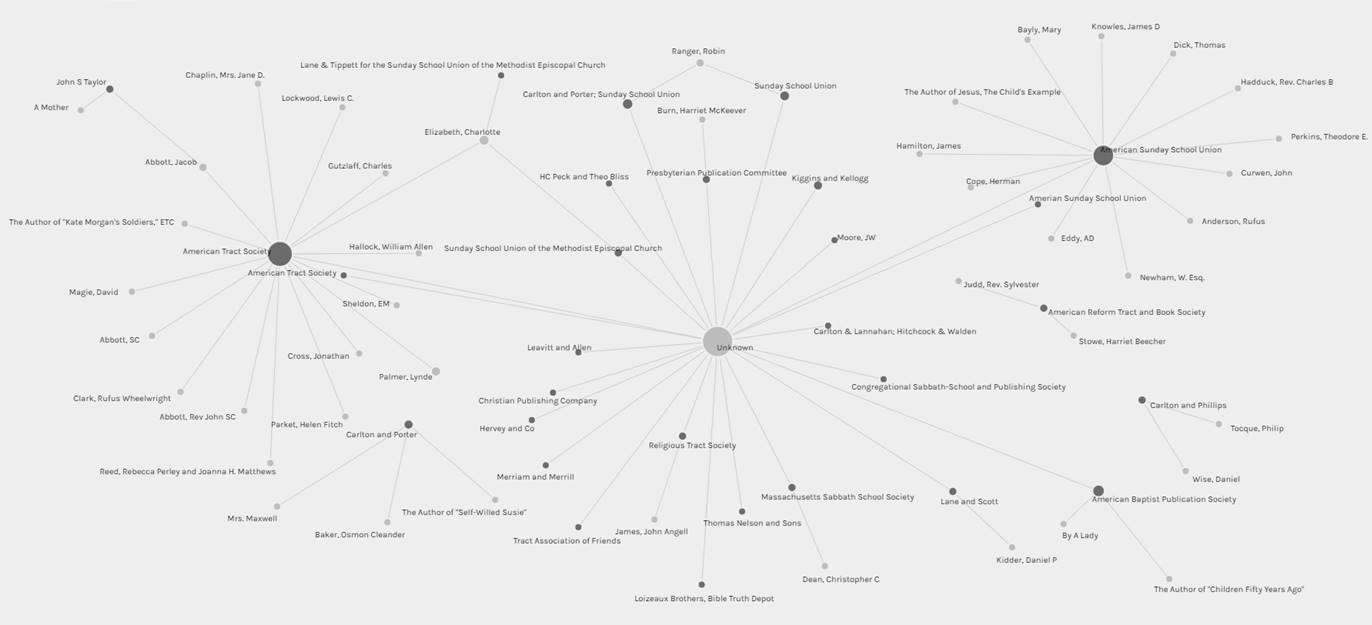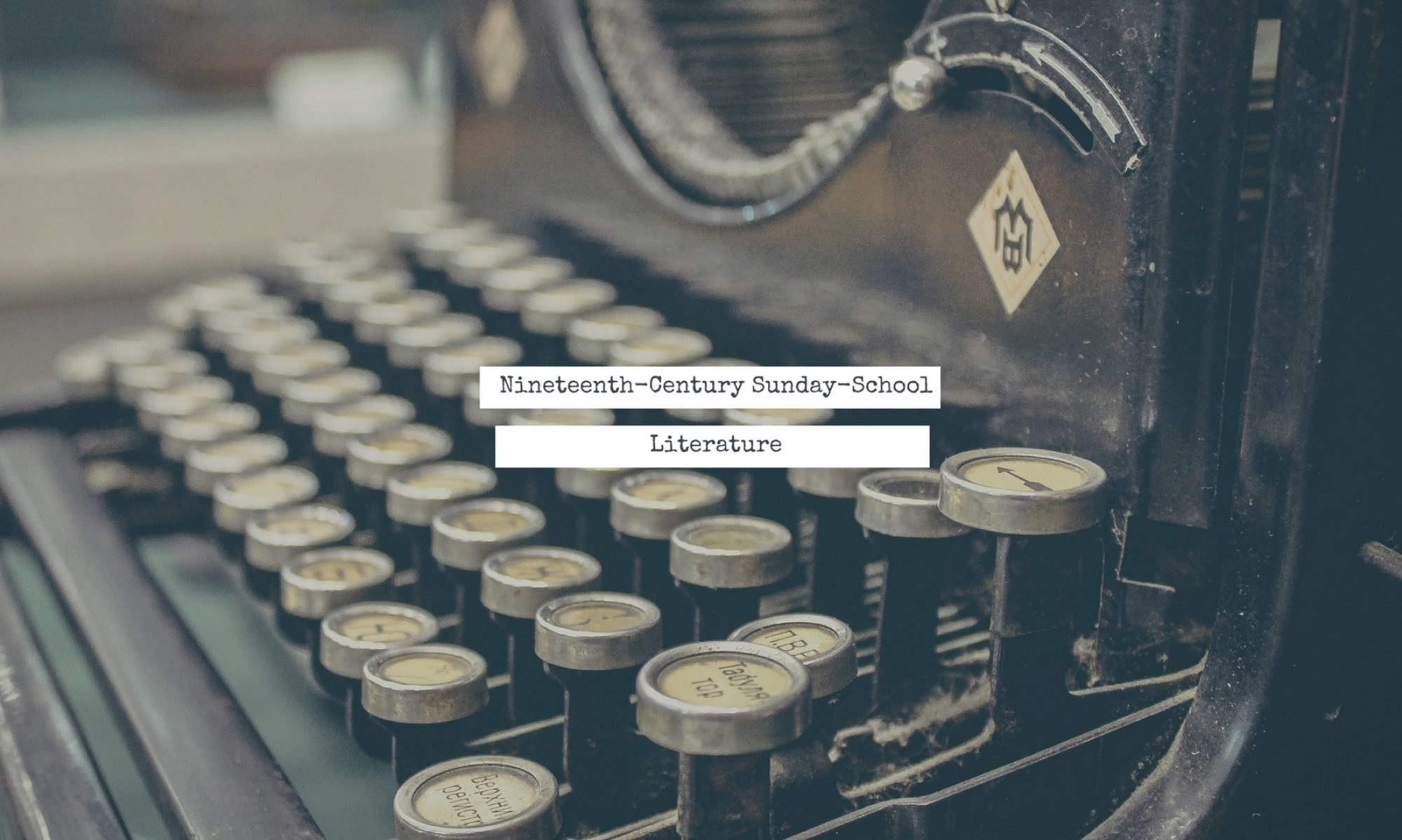Examining the authorship of the sunday school books helps us gain a clearer understanding of who was influencing the moral systems within religious education during the nineteenth century. However, this is incredibly hard to accomplish if a vast percentage of the authors assumed anonymity or were simply omitted from the book’s title page. This was certainly the case for our dataset, as it suggests that it was more acceptable to publish religious works with unknown authors throughout the nineteenth century.
According to Weir and Lorang, “anonymity…was a fundamental characteristic of nineteenth-century American literary culture.” As we have continued our research and production of multiple visualizations, we have fostered a continuous curiosity about all of our authors, both known and unknown. Even if the author is listed within our data set, variations of anonymity continue to persist. Often, this is in the form of either “author of [insert different book title]”, or authors denoted by their specific titles such as “A Mother” or “A Lady”. In other circumstances, the author is listed as a society, such as the “American Baptist Publication Society” or the “American Tract Society”. It is curious that only female authors are occasionally named by their title (such as Mrs. Follen and Mrs. J Sadlier), whereas male authors are occasionally named by the title given to them by their profession (such as Rev John P. Carter). As a result of our everlasting curiosity towards these authors, we have continued to ask research questions so that we may learn more about them. For this particular visualization, we were interested in analyzing the relationship between the authors and publishers.
In order to gain a fuller understanding of the unknown authors within our dataset, we created this network to analyze the connection between authors and publishers. By comparing these two categories in our dataset, we hoped to identify connections between the vast amount of unknown authors and certain publishing houses, specific authors and specific publishing houses, and multiple publishing houses through authors that they had in common.

Click on the visualization in order to get a closer view on the data points.
This visualization of data clearly portrays these relationships through drawing connections between all of the authors and all of the publishing houses. In this visualization, the darker circles denote specific publishers, while the lighter circles represent each author included in our data set. The size of the circles suggest the amount of relationships that author or publisher has with other authors or publishers. The bigger the circle, the more relationships. For the sake of clarity and readability, we have provided a zoomed in screenshot of this network and zoomed out screenshot. (Note that the zoomed out screenshot appears to have multiple circles denoted for the same publisher. This is result of a dataset error. When we tried to correct this mistake, it was incredibly hard to make the zoomed out screenshot even partially readable.) It is much harder to read the zoomed out version. But since the specifics that we analyze are in the zoomed-in version, the function of the zoomed out version is merely to show how many connections exist outside of the central focus, showing the individual publishers that only published one work.
 Click on the visualization in order to get a closer view on the data points.
Click on the visualization in order to get a closer view on the data points.
By further examining this network, the relationships between the authors and publishers are a bit more complex than we had originally anticipated. Some authors, such as Charlotte Elizabeth, are connected to as much as three different publishing houses. However, most authors are only connected to one. Some authors and publishers are only connected to each other, whereas others have multiple connections. Some publishing houses only produced books with unknown authors, whereas others produced books with both known and unknown authors.
This network also points out the sheer mass of books with unknown authors in a clearer and more apparent way than both our graph and map. The graph is meant to solely analyze the different books with unknown information, whereas the map is meant to exhibit where each of the books originated. This network compares the books with known and unknown authors and more clearly exhibits how prevalent authorship anonymity was throughout the nineteenth century.
These Sunday School books are marked as building blocks to early developments of twentieth century alias fictional and theological writing. A hypothesis of our own is that the authors took an unknown name out of fear of being ridiculed by a publisher or the Church. In modern times, the most common reason to not claiming authorship of a book is to separate their texts from earlier their works that were unsuccessful.
Unknown authors made up a large part of the relational similarities. Most publishers curated from the dataset had published authors with no claim to their book titles. The most widely published books were derived from the American Tract Society. The American Tract Society published an extensive amount of unknown authors during this time period. Authors who were bound by contract would often go under aliases with other book titles to increase wealth and notoriety.
As a result of our analysis of these relationships, we have made multiple speculation that we hope to eventually confirm and support with further research:
Authors struggled to maintain a particular status quo. Multiple authors would go under aliases and other titles so that they may be published more often. Often, if authors had a name in the secular world, they would not want their title to be recognized in a religious context. We believe that this was due to potentially conflicting views between their secular and religious workings. Authors would not want their fans of one sect, journeying into another. This was because they did not want their work of other genres or disciplines influencing them in a negative fashion.
By further speculating the causes for the vast quantity of unknown authors, we hope to continue to further interpret our dataset, discovering the intent of these books within the religious upbringing and education of youth within the nineteenth century.
